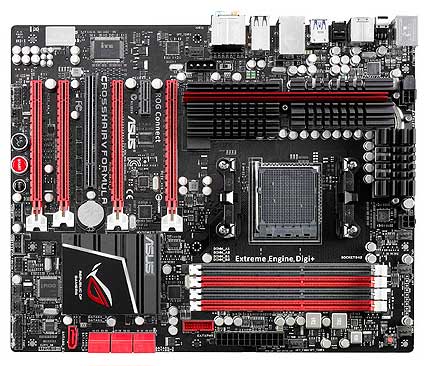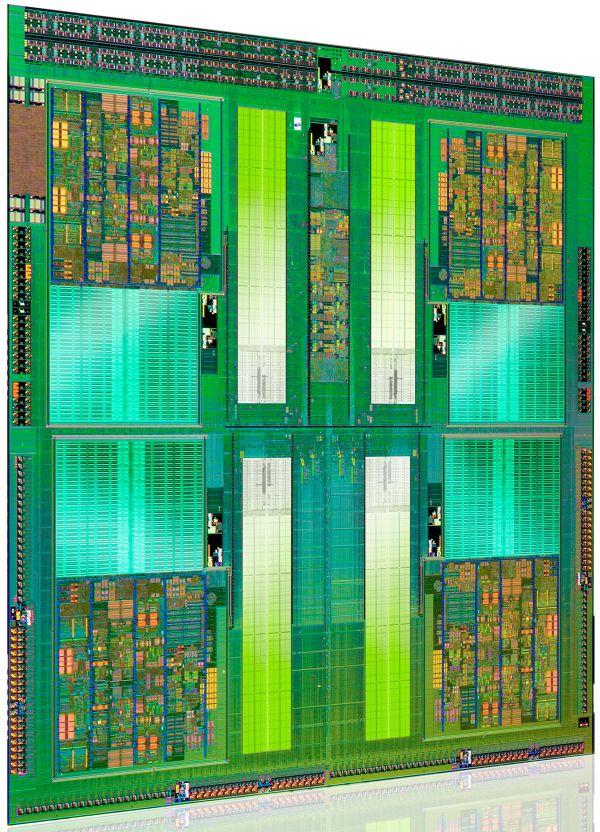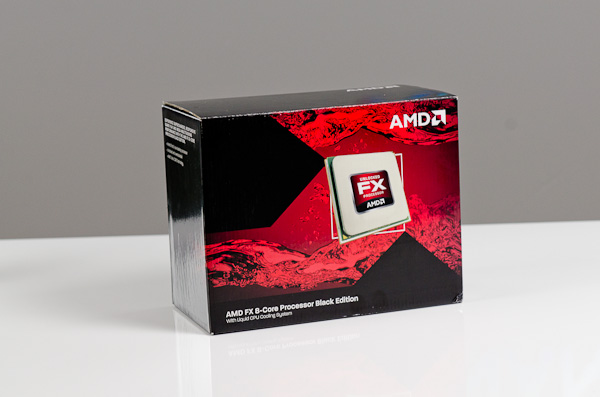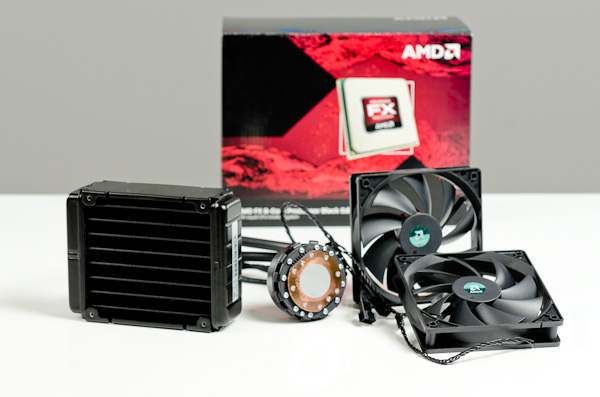The Bulldozer Review: AMD FX-8150 Tested
by Anand Lal Shimpi on October 12, 2011 1:27 AM ESTAMD has been trailing Intel in the x86 performance space for years now. Ever since the introduction of the first Core 2 processors in 2006, AMD hasn't been able to recover and return to the heyday of the Athlon 64 and Athlon 64 X2. Instead the company has remained relevant by driving costs down and competing largely in the sub-$200 microprocessor space. AMD's ability to hold on was largely due to its more-cores-for-less strategy. Thanks to aggressive pricing on its triple and hexa-core parts, for users who needed tons of cores, AMD has been delivering a lot of value over the past couple of years.
Recently however Intel has been able to drive its per-core performance up with Sandy Bridge, where it's becoming increasingly difficult to recommend AMD alternatives with higher core counts. The heavily threaded desktop niche is tough to sell to, particularly when you force users to take a significant hit on single threaded performance in order to achieve value there. For a while now AMD has needed a brand new architecture, something that could lead to dominance in heavily threaded workloads while addressing its deficiencies in lightly threaded consumer workloads. After much waiting, we get that new architecture today. Bulldozer is here.
It's branded the AMD FX processor and it's only available in a single die configuration. Measuring 315mm2 and weighing in at around 2 billion transistors (that's nearly GPU-sized fellas), Bulldozer isn't that much smaller than existing 45nm 6-core Phenom II designs despite being built on Global Foundries' 32nm SOI process. Both die area and transistor count are up significantly over Sandy Bridge, which on Intel's 32nm HKMG process is only 995M transistors with a die size of 216mm2. This is one big chip.
| CPU Specification Comparison | ||||||||
| CPU | Manufacturing Process | Cores | Transistor Count | Die Size | ||||
| AMD Bulldozer 8C | 32nm | 8 | 1.2B* | 315mm2 | ||||
| AMD Thuban 6C | 45nm | 6 | 904M | 346mm2 | ||||
| AMD Deneb 4C | 45nm | 4 | 758M | 258mm2 | ||||
| Intel Gulftown 6C | 32nm | 6 | 1.17B | 240mm2 | ||||
| Intel Nehalem/Bloomfield 4C | 45nm | 4 | 731M | 263mm2 | ||||
| Intel Sandy Bridge 4C | 32nm | 4 | 995M | 216mm2 | ||||
| Intel Lynnfield 4C | 45nm | 4 | 774M | 296mm2 | ||||
| Intel Clarkdale 2C | 32nm | 2 | 384M | 81mm2 | ||||
| Intel Sandy Bridge 2C (GT1) | 32nm | 2 | 504M | 131mm2 | ||||
| Intel Sandy Bridge 2C (GT2) | 32nm | 2 | 624M | 149mm2 | ||||
Update: AMD originally told us Bulldozer was a 2B transistor chip. It has since told us that the 8C Bulldozer is actually 1.2B transistors. The die size is still accurate at 315mm2.
Architecturally Bulldozer is a significant departure from anything we've ever seen before. We'll go into greater detail later on in this piece, but the building block in AMD's latest architecture is the Bulldozer module. Each module features two integer cores and a shared floating point core. FP hardware is larger and used less frequently in desktop (and server workloads), so AMD decided to share it between every two cores rather than offer a 1:1 ratio between int/fp cores on Bulldozer. AMD advertises Bulldozer based FX parts based on the number of integer cores. Thus a two module Bulldozer CPU, has four integer cores (and 2 FP cores) and is thus sold as a quad-core CPU. A four module Bulldozer part with eight integer cores is called an eight-core CPU. There are obvious implications from a performance standpoint, but we'll get to those shortly.
The FX Lineup
There are a total of 7 AMD FX CPUs that AMD is announcing today, although only four are slated for near-term availability.
| CPU Specification Comparison | |||||||||
| Processor | Cores | Clock Speed | Max Turbo | NB Clock | L2 Cache | TDP | Price | ||
| AMD FX-8150 | 8 | 3.6GHz | 4.2GHz | 2.2GHz | 8MB | 125W | $245 | ||
| AMD FX-8120 | 8 | 3.1GHz | 4.0GHz | 2.2GHz | 8MB | 95W/125W | $205 | ||
| AMD FX-8100* | 8 | 2.8GHz | 3.7GHz | 2GHz | 8MB | 95W | N/A | ||
| AMD FX-6100 | 6 | 3.3GHz | 3.9GHz | 2GHz | 6MB | 95W | $165 | ||
| AMD FX-4170* | 4 | 4.2GHz | 4.3GHz | 2.2GHz | 4MB | 125W | N/A | ||
| AMD FX-B4150* | 4 | 3.8GHz | 4GHz | 2.2GHz | 4MB | 95W | N/A | ||
| AMD FX-4100 | 4 | 3.6GHz | 3.8GHz | 2GHz | 4MB | 95W | $115 | ||
| AMD Phenom II X6 1100T | 6 | 3.2GHz | 3.6GHz | 2GHz | 3MB | 125W | $190 | ||
| AMD Phenom II X4 980 | 4 | 3.7GHz | N/A | 2GHz | 2MB | 125W | $170 | ||
The FX-8150, 8120, 6100 and 4100 are what's launching today. The first digit in AMD's FX model numbers indicates the number of cores with the 8150 and 8120 boasting eight, while the 6100 only has six active integer cores (three Bulldozer modules). The FX-4100 features four integer cores. L2 cache scales with core count (2MB per module), while the L3 cache size remains fixed at 8MB regardless of SKU.
North Bridge and L3 cache frequency alternate between 2.0GHz and 2.2GHz depending on the part. TDPs range between 95W and 125W as well, with the FX-8120 being offered in both 125W and 95W versions.
There's only a single Bulldozer die. The 6 and 4 core versions simply feature cores disabled on the die. AMD insists this time around, core unlocking won't be possible on these harvested parts.
The huge gap in clock speed between the 8120 and 8150 are troubling. Typically we see linear frequency graduations but the fact that there's a 16% difference between these two SKUs seems to point to process problems limiting yield at higher frequencies—at least for the 8-core version.
Outside of the quad-core and hex-core Bulldozer pats, the only other FX processor able to exceed the 3.3GHz clock speed of the Phenom II X6 1100T is the 8150. And if you include quad-core Phenom II parts in the mix, only two Bulldozer parts ship at a higher stock frequency than the Phenom II X4 980. Granted Turbo Core will help push frequencies even higher, but these low base frequencies are troubling. For an architecture that was designed to scale to clock speeds 30% higher than its predecessor, Bulldozer doesn't seem to be coming anywhere close.
The entire FX lineup ships unlocked, which allows for some easy overclocking as you'll see soon enough.
Motherboard Compatibility
AMD is certifying its FX processors for use on Socket-AM3+ motherboards. Owners of standard AM3 motherboards may be out of luck, although motherboard manufacturers can choose to certify their boards for use with Bulldozer if they wish to do so. From AMD's perspective however, only AM3+ motherboards with BIOS/UEFI support for Bulldozer are officially supported.
All existing AM2/AM2+/AM3/AM3+ heatsinks should work with the FX processor; they simply need to be rated for the TDP of the processor you're looking to cool.

For this review, AMD supplied us with ASUS' Crosshair V Formula AM3+ motherboard based on AMD's 990FX chipset.
AMD does offer six 6Gbps SATA ports on its 990FX chipset, a significant upgrade from the two 6Gbps ports on Intel's 6-series chipsets. Unbuffered ECC memory is also supported for those who desire the added security, once again a feature not supported on Intel's consumer grade 6-series chipsets.
Despite AMD's trend towards releasing APUs with integrated GPUs (thus requiring a new socket), AMD insists that the AM3+ platform will live to see one more processor generation before it's retired.
AMD's Liquid CPU Cooling System
Alongside its new FX processors AMD is introducing its first branded liquid cooling system manufactured by Asetek.
AMD's cooling system is similar to other offerings from companies like Antec and Corsair. The system is self contained, you never have to worry about adding any more liquid to it.
Attach the cooling module to your CPU socket via a simple bracket, and affix the radiator to your case and you're good to go. The radiator is cooled via two 120mm fans, also included in the box.
AMD doesn't have an exact idea on pricing or availability of its liquid cooling solution, but I'm told to expect it to be around $100 once available. My sample actually arrived less than 12 hours ago, so expect a follow up with performance analysis later this week.
The Roadmap
For the first time in far too long, AMD is actually being very forthcoming about its future plans. At a recent tech day about Bulldozer, AMD laid out its CPU core roadmap through 2014. The code names are below:
Piledriver you already know about, it's at the heart of Trinity, which is the 2—4 core APU due out in early 2012. Piledriver will increase CPU core performance by around 10—15% over Bulldozer, although it will initially appear in a lower performance segment. Remember that final generation of AM3+ CPU I mentioned earlier? I fully expect that to be a GPU-less Piledriver CPU due out sometime in 2012.
Steamroller will follow in 2013, again improving performance (at the core level) by around 10—15%. Excavator will do the same in 2014. AMD believes that these performance increases will be sufficient to keep up with Intel over time, however I'll let you be the judge of that once we get to the Bulldozer performance numbers.
The other thing to note about AMD's roadmap is it effectively puts the x86 business on an annual cadence, in line with what we've seen from the AMD GPU folks. Although AMD isn't talking about what process nodes to expect all of these cores at, it looks like AMD will finally have an answer to Intel's tick-tock release schedule moving forward.























430 Comments
View All Comments
Gasaraki88 - Friday, October 21, 2011 - link
I think the main competitor for Intel in the future is going to be the ARM processor makers. As Intel goes in to that space with the x86 and the ARM chips getting faster and faster and Windows 8 supporting ARM, you get a mix and soon ARM chip will invade the desktop/laptop market.AMD is done.
ppro - Monday, October 24, 2011 - link
I decided to get this new cpu from www.amd.comnavair2 - Monday, October 24, 2011 - link
I decided to try AMD when I "inherited" my brother's older socket 939 hardware some years ago, then built my own using a Phenom II X4 940 BE.At the time it was released, the 940 wasn't too far behind the i7 920 in many respects, plus it was about $70 cheaper...I was very satisfied with my decision. However, after 3 years of advancement by both companies and watching Intel ONCE AGAIN come up with something that gives excellent performance with ever-increasing power reduction, I was on the fence about Bulldozer even before the reviews came out.
Once I saw the majority of the reviews, I knew what side of the fence to be on for obvious reasons..."Bulldozer" just didn't hit the expectations I thought it should, especially when it comes to load power consumption. Perhaps in a couple years when it matures, but I didn't feel like waiting for AMD to iron out all the wrinkles.
My next build is already done and sorry to say, it's NOT AMD. For what I do the i5-2500K is just too good to pass up at combo prices that result in a $200 processor ( less than what I payed for my X4 940 when IT was new).
Best wishes AMD, I hope you can make "Bulldozer" work, but for now "BD" stands for "Big Disappointment". I'll check back with you in a year or so to see how things are doing.
johnsmith9875 - Tuesday, October 25, 2011 - link
Intel's first "dual core" was actually 2 processors on one chip.They could have saved a lot of engineering time by merely shoehorning two X6 Thuban processors together at 32nm and sell it as a 12 core. Now that would have rocked!
Poxenium - Wednesday, October 26, 2011 - link
Does anybody remember the first Intel processors with the entirely new architecture called Core Duo, Conroe-L or something ? They were pretty lousy at first, with slightly higher performance than the previous generation, but constantly overheating. later the Core 2 Duo was a complete success, not to mention the first generation iCore processors and of course Sandy Bridge.Considering the fact that these Bulldozer processors are AMD's first attempt at a completely new architecture, I say that both performance and power consumption are at reasonable levels. Upcoming models will surely do a lot better.
shbdf - Friday, November 4, 2011 - link
== ( http://www.amtata.com )====
== ( http://www.amtata.com )====
Handbags(Coach l v f e n d i d&g) $35
Tshirts (Polo ,ed hardy,lacoste) $15
Wolfpup - Friday, November 4, 2011 - link
I'd love to see how well the SMP client runs on an "8 core" Bulldozer part compared with a quad Sandy Bridge, and for that matter a 6 core Phenom 2 and 6 core Nehalam.It SEEMS like it should do really well, right? Or not? Because basically an 8 core Bulldozer is a quad core when it comes to floating point, right? And Folding uses a lot of floating point? Or...?
Also, if it really has double the transistor count of Sandy Bridge...where is the performance? It seems like even on heavily threaded stuff it's just kind of about equal with Sandy Bridge, which doesn't seem right....
JumpingJack - Sunday, November 6, 2011 - link
Except for the fact even with that 'professional' software the competitor is just as fast or faster consuming 30% less power.it is unfortunate for AMD and their fan base bit BD is definitely a dud.
JumpingJack - Sunday, November 6, 2011 - link
Considering the power consumption and the reported problems with many games, e.g. Dues Ex, Portal 2, Shogun ... I would see this more appealing around the $180 mark. The 1100T is a better buy if you must do AMD.JumpingJack - Sunday, November 6, 2011 - link
The statement is partially true. There are quite a few apps that the Thuban outnguns BD and many cases where it out performs on energy effiency as well.